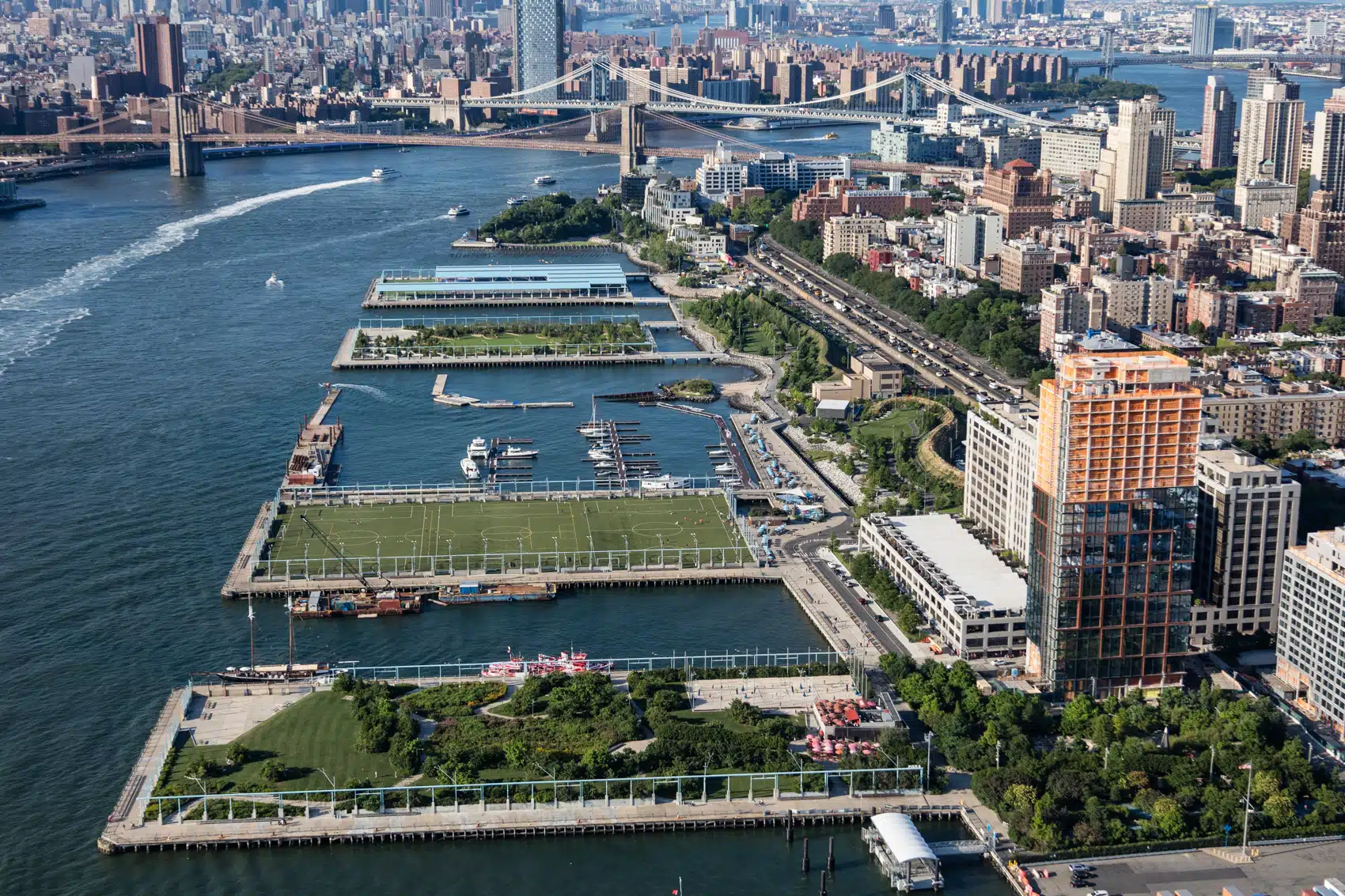‘To Brooklyn Bridge’ by Hart Crane
Hart Crane’s long-form poem ‘The Bridge’ is far and away the greatest literary work inspired by the Brooklyn Bridge. First published in 1930, the poem series was controversial for its experimental style, length, and lack of narrative, but its eclectic mix of various meters with free-form verse is electrifying, and its opening poem, ‘To Brooklyn Bridge,’ encapsulates this energy perfectly. Crane uses the bridge’s towers and cables as symbols for spiritual ascendancy, creating an ecstatic picture of urban modernity.
Audio Player
To Brooklyn Bridge
Hart Crane
How many dawns, chill from his rippling rest
The seagull’s wings shall dip and pivot him,
Shedding white rings of tumult, building high
Over the chained bay waters Liberty—
Then, with inviolate curve, forsake our eyes
As apparitional as sails that cross
Some page of figures to be filed away;
—Till elevators drop us from our day . . .
I think of cinemas, panoramic sleights
With multitudes bent toward some flashing scene
Never disclosed, but hastened to again,
Foretold to other eyes on the same screen;
And Thee, across the harbor, silver-paced
As though the sun took step of thee, yet left
Some motion ever unspent in thy stride,—
Implicitly thy freedom staying thee!
Out of some subway scuttle, cell or loft
A bedlamite speeds to thy parapets,
Tilting there momently, shrill shirt ballooning,
A jest falls from the speechless caravan.
Down Wall, from girder into street noon leaks,
A rip-tooth of the sky’s acetylene;
All afternoon the cloud-flown derricks turn . . .
Thy cables breathe the North Atlantic still.
And obscure as that heaven of the Jews,
Thy guerdon . . . Accolade thou dost bestow
Of anonymity time cannot raise:
Vibrant reprieve and pardon thou dost show.
O harp and altar, of the fury fused,
(How could mere toil align thy choiring strings!)
Terrific threshold of the prophet’s pledge,
Prayer of pariah, and the lover’s cry,—
Again the traffic lights that skim thy swift
Unfractioned idiom, immaculate sigh of stars,
Beading thy path—condense eternity:
And we have seen night lifted in thine arms.
Under thy shadow by the piers I waited;
Only in darkness is thy shadow clear.
The City’s fiery parcels all undone,
Already snow submerges an iron year . . .
O Sleepless as the river under thee,
Vaulting the sea, the prairies’ dreaming sod,
Unto us lowliest sometime sweep, descend
And of the curveship lend a myth to God.
‘Granite and Steel’ by Marianne Moore
Marianne Moore was one of the most important NYC poets in the period following World War I — she edited the popular arts journal, Dial, and won the Pulitzer Prize for her Collected Poems in 1951. Throughout Moore’s life, she was inspired by the Brooklyn Bridge; to her, it was ‘synonymous with endurance’ and ‘united by stress.’ Her glorious poem, ‘Granite and Steel.’ celebrates it as such — a physical embodiment of lofty ideals, a ‘caged Circe of steel and stone.’
Audio Player
Granite and Steel
Marianne Moore
Enfranchising cable, silvered by the sea,
of woven wire, grayed by the mist,
and Liberty dominate the Bay—
her feet as one on shattered chains,
once whole links wrought by Tyranny.
Caged Circe of steel and stone,
her parent German ingenuity.
“O catenary curve” from tower to pier,
implacable enemy of the mind’s deformity,
of man’s uncompunctious greed,
his crass love of crass priority,
just recently
obstructing acquiescent feet
about to step ashore when darkness fell
without a cause,
as if probity had not joined our cities
in the sea.
“O path amid the stars
crossed by the seagull’s wing!”
“O radiance that doth inherit me!”
—affirming inter-acting harmony!
Untried expedient, untried; then tried;
sublime elliptic two-fold egg—
way out; way in; romantic passageway
first seen by the eye of the mind,
then by the eye. O steel! O stone!
Climactic ornament, double rainbow,
as if inverted by French perspicacity
John Roebling’s monument,
German tenacity’s also;
composite span—an actuality.
‘The Bridge, Palm Sunday, 1973’ by Alfred Corn
The bridge doesn’t always represent ascendancy — it can also be a symbol for connection. That is certainly the case in ‘The Bridge, Palm Sunday‘, a touching rumination on brotherly love by the prolific contemporary poet, Alfred Corn. Referring back to Crane’s epic poem, Corn tries to engage with him in a dialogue across the ‘sentence’ of the bridge, turning the bridge into a place for spiritual connection — connection across the ‘islands’ of space, time, and people themselves. The poem’s prose-like rhythm is perfectly matched by its earnest emotion.
Audio Player
‘City That Does Not Sleep (Nightsong of Brooklyn Bridge)’ by Federico García Lorca
Not all poets view the bridge as a symbol of noble inspiration. Federico García Lorca, for one, saw it as a symbol of all that is sick and poisonous in industrial society. García Lorca was a Spanish avant-garde poet of the early 20th century, and ‘City That Does Not Sleep‘ displays his mortal terror in the face of urban industrialism. It reads like a fever dream declaring a prophetic omen. Morbid imagery and strange leaps of logic characterize this surrealist classic, which is not for the faint of heart.
Audio Player
City That Does Not Sleep (Nightsong of Brooklyn Bridge)
Federico García Lorca
In the sky there is nobody asleep. Nobody, nobody.
Nobody is asleep.
The creatures of the moon sniff and prowl about their cabins.
The living iguanas will come and bite the men who do not
dream,
and the man who rushes out with his spirit broken will meet on
the street corner
the unbelievable alligator quiet beneath the tender protest of
the stars.
Nobody is asleep on earth. Nobody, nobody.
Nobody is asleep.
In a graveyard far off there is a corpse
who has moaned for three years
because of a dry countryside on his knee;
and that boy they buried this morning cried so much
it was necessary to call out the dogs to keep him quiet.
Life is not a dream. Careful! Careful! Careful!
We fall down the stairs in order to eat the moist earth
or we climb to the knife edge of the snow with the voices of the
dead dahlias.
But forgetfulness does not exist, dreams do not exist;
flesh exists. Kisses tie our mouths
in a thicket of new veins,
and whoever his pain pains will feel that pain forever
and whoever is afraid of death will carry it on his shoulders.
One day
the horses will live in the saloons
and the enraged ants
will throw themselves on the yellow skies that take refuge in the
eyes of cows.
Another day
we will watch the preserved butterflies rise from the dead
and still walking through a country of gray sponges and silent
boats
we will watch our ring flash and roses spring from our tongue.
Careful! Be careful! Be careful!
The men who still have marks of the claw and the thunderstorm,
and that boy who cries because he has never heard of the
invention of the bridge,
or that dead man who possesses now only his head and a shoe,
we must carry them to the wall where the iguanas and the snakes
are waiting,
where the bear’s teeth are waiting,
where the mummified hand of the boy is waiting,
and the hair of the camel stands on end with a violent blue
shudder.
Nobody is sleeping in the sky. Nobody, nobody.
Nobody is sleeping.
If someone does close his eyes, a whip, boys, a whip!
Let there be a landscape of open eyes and bitter wounds on fire.
No one is sleeping in this world. No one, no one.
I have said it before.
No one is sleeping.
But if someone grows too much moss on his temples during the night, open the stage trapdoors so he can see in the moonlight
the lying goblets, and the poison, and the skull of the theaters.
‘National Cold Storage Company’ by Harvey Shapiro
As the editor of the New York Times Book Review and the New York Times Magazine, the late Harvey Shapiro was a staple of NYC literary culture, and he was also a brilliant poet. Shapiro’s poetry was urban, with a sharp sense of humor and irony, as is seen in National Cold Storage Company, which subverts Crane’s romantic view of the bridge in witty Shapiro style. Underneath this urban irony, there is a more unsettling suggesting at play here — that everything is subject to the erasure of time.
Audio Player
National Cold Storage Company
Harvey Shapiro
The National Cold Storage Company contains
More things than you can dream of.
Hard by the Brooklyn Bridge it stands
In a litter of freight cars,
Tugs to one side; the other, the traffic
Of the Long Island Expressway.
I myself have dropped into it in seven years
Midnight tossings, plans for escape, the shakes.
Add this to the national total —
Grant’s tomb, the Civil War, Arlington,
The young President dead.
Above the warehouse and beneath the stars
The poets creep on the harp of the Bridge.
But see,
They fall into the National Cold Storage Company
One by one. The wind off the river is too cold,
Or the times too rough, or the Bridge
Is not a harp at all. Or maybe
A monstrous birth inside the warehouse
Must be fed by everything — ships, poems,
Stars, all the years of our lives.
‘Don’t Forget Ta Live Like You’ by Sara Beck
Though not nearly as famous as Kerouac or Crane, Sara Beck is a poet and journalist who crafted a wonderful little bridge-inspired pantoum for the New York Times. The poem is a Mad-Lib-like arrangement of bits of writing she found on the Brooklyn, Manhattan, and Williamsburg bridges. Her keen aesthetic sense takes a series of clichés and makes them not just bearable, but truly pleasurable to read.
Audio Player






